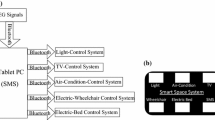Abstract
The electroencephalograph (EEG) learning network model (EEGNet) is developed according to the convolutional neural network model architecture. It can be applied in the area of the EEG recognition because the EEGNet has the advantage of adapting to the EEG processing. However, the application has a bottleneck problem that the EEG selection of the specific brain–computer interface (BCI) affects the EEGNet recognition accuracy. In this paper, we developed an integrated EEGNet model of the human vision mechanism for light intensity perception. First, the special BCI is constructed by using a designed multiplexer, the EEG acquisition circuit, the magnifier and the filter. Second, the effect of the underground environment illumination on EEG is explored by using the constructed BCI. Third, the model of the vision mechanism is established by using the integrated EEGNet. Finally, experiments show that the integrated EEGNet increases the light intensity recognition accuracy respectively by 8.4% and 3.9%, compared with the multi-channel EEGNet and the single channel EEGNet. The integrated EEGNet effectively perceives and recognizes the underground illumination intensities, dim intensity of 0–60 Lx, mild intensity of 61–120 Lx, and bright intensity of 121–350 Lx. The proposed model can provide useful references for miner helmet or other special environment light-related devices.
















Similar content being viewed by others
Explore related subjects
Discover the latest articles, news and stories from top researchers in related subjects.References
Wang YT, Nakanishi M, Wang YJ, Wei CS, Cheng CK, Jung TP (2017) An online brain-computer interface based on SSVEPs measured from non-hair-bearing areas. IEEE Trans Neural Syst Rehabil Eng 25(1):11–18
Martell MJ, Sammarco JJ, Macdonald BD (2019) Effects of light spectrum on luminance measurements in underground coal mines. IEEE Trans Ind Appl 55(6):6670–6677
Baghdadi G, Amiri M, Falotico E, Laschi C (2021) Recurrence quantification analysis of EEG signals for tactile roughness discrimination. Int J Mach Learn Cybern 12:1115–1136
Kriegeskorte N (2015) Deep neural networks: a new framework for modeling biological vision and brain information processing. Ann Rev Vis Sci 1:417–446
She Q, Zou J, Meng M, Fan Y, Luo Z (2021) Balanced graph-based regularized semi-supervised extreme learning machine for EEG classification. Int J Mach Learn Cybern 12:903–916
Tayeb Z, Bose R, Dragomir A, Osborn LE, Thakor NV, Cheng G (2020) Decoding of pain perception using EEG signals for a real-time reflex system in prostheses: a case study. Sci Rep 10(1):1–11
Talukdar U, Hazarika SM, Gan JQ (2018) A kernel partial least square based feature selection method. Pattern Recogn 83(2018):91–106
Kompier ME, Smolders KC, van Marken Lichtenbeltb W D, de Kort YAW (2020) Effects of light transitions on measures of alertness, arousal and comfort. Physiol Behav 5(1):1–30
Abuella H, Ekin S (2020) Non-contact vital signs monitoring through visible light sensing. IEEE Classifiers J 20(7):3859–3870
Wang M, Qu W, Chen WY (2018) Hybrid sensing and encoding using pad phone for home robot control. Multimed Tools Appl 77(9):10773–10786
Coito A, Michel CM, Vulliemoz S, Plomp G (2018) Directed functional connections underlying spontaneous brain activity. Hum Brain Mapp 40(3):879–888
Kong Y, Yu T (2018) A deep neural network model using random forest to extract feature representation for gene expression data classification. Sci Rep 8(1):1–9
Chu NN (2017) Surprising prevalence of electroencephalogram brain-computer interface to internet of thing. IEEE Consumer Electron Mag 6(2):31–39
Bernardi G, Betta M, Ricciardi E, Pietrini P, Tononi G, Siclari F (2019) Regional delta waves in human rapid eye movement sleep. J Neurosci 39(14):2686–2697
Moreno CAA, Manian V, Rodriguez D, Valera J (2019) Auditory source localization by time frequency analysis and classification of electroencephalogram signals. Biomed J Sci Tech Res 19(5):14595–14606
Wang M, Zhang S, Lv Y, Lu H (2018) Anxiety level detection using BCI of Miner’s smart helmet. Mobile Netw Appl 23(2):336–343
Lu H, Li Y, Chen M (2018) Brain intelligence: go beyond artificial intelligence. Mobile Netw Appl 23:368–375
He L, Hu D, Wan M, Wen Y, Deneen KMV, Zhou M (2016) Common Bayesian network for classification of EEG-based multiclass motor imagery BCI. IEEE Trans Syst Man Cybern Syst 46(6):843–854
Schindler S, Wegrzyn M, Steppacher I, Kissler J (2015) Perceived communicative context and emotional content amplify visual word processing in the fusiform gyrus. J Neurosci 35(15):6010–6019
Wang W, Zhang G, Yang L, Balaji VS, Elamaran V, Arunkumar N (2019) Revisiting signal processing with spectrogram analysis on EEG, ECG and speech signals. Futur Gener Comput Syst 98:227–232
Wang M, Huang Z, Li Y, Dong L, Pan H (2021) Maximum weight multi-modal information fusion algorithm of electroencephalographs and face images for emotion recognition. Comput Electr Eng 94(2021):107319:1-107319:13
Lu HM, Yang R, Deng ZR, Zhang YL, Gao GW, Lan RS (2021) Chinese image captioning via fuzzy attention-based denseNet-BiLSTM. ACM Trans Multimed Comput Commun Appl 17(1s):1–18
Wang M, Ma C, Li ZH, Zhang SZ, Li YC (2021) Alertness estimation using connection parameters of the brain network. IEEE Trans Intell Transport Syst 23:1–10
Acknowledgements
This work is supported by the Natural Science Foundation Key Project of China under Grant 61834005, the Chinese Society of Academic Degrees and Graduate Education under Grant B-2017Y0002-170, and Shaanxi Province Key Research and Development Project under Frants 2016GY-040, Yulin City Science and Technology Project under Grants CXY-2020-026. Besides, we sincerely appreciate the editors and reviewers for their valuable suggestions and questions.
Author information
Authors and Affiliations
Corresponding author
Additional information
Publisher's Note
Springer Nature remains neutral with regard to jurisdictional claims in published maps and institutional affiliations.
Rights and permissions
Springer Nature or its licensor (e.g. a society or other partner) holds exclusive rights to this article under a publishing agreement with the author(s) or other rightsholder(s); author self-archiving of the accepted manuscript version of this article is solely governed by the terms of such publishing agreement and applicable law.
About this article
Cite this article
Wang, M., Cheng, H., Li, Y. et al. Vision mechanism model using brain–computer interface for light sensing. Int. J. Mach. Learn. & Cyber. 14, 2709–2722 (2023). https://doi.org/10.1007/s13042-023-01793-x
Received:
Accepted:
Published:
Issue Date:
DOI: https://doi.org/10.1007/s13042-023-01793-x




